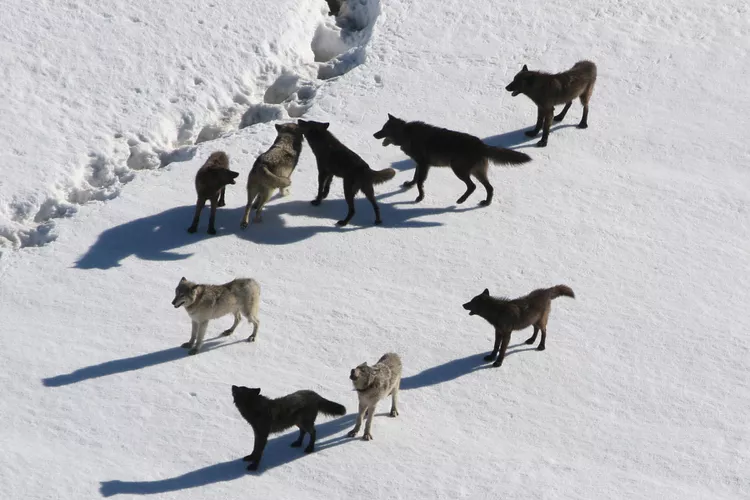Wolf Watching in Yellowstone National Park
Nathan Varley, founder of Yellowstone Wolf Tracker, is leading wolf watchers on the national park trip of a lifetime.
According to the Chinese zodiac calendar, 2021 is the year of the ox. However, wildlife biologists argue it could be the year of the wolf. Moreover, it is easy to claim that there’s never been a better time for wolf watching in Yellowstone, where the wolf population is estimated to be up by as much as 20 percent. Last year marked a quarter of a century since wolves were reintroduced to the park. Today, Yellowstone is home to some of the best wolf watching in the world. Yellowstone’s gray wolves remain oblivious to our global pandemic or their removal from the endangered species list; all they know is they must survive another winter.
Why Winter is Ideal for Wolf Watching
It’s no secret that winter is one of the best times to visit Yellowstone, especially for wolf watching. While the park’s bears are hibernating, its eight different wolf packs are concentrated in lower elevations where their prey—mainly elk and bison—are feeding. Consequently, wolves are easier to find and photograph against a backdrop of white. Nevertheless, just because you visit in winter doesn’t guarantee a sighting; that’s where a wolf tracker comes in.
Expert Guidance for Wolf Watching
“There’s definitely a DIY version of wolf watching, but to maximize effort and time, it pays to go with a guide,” says Nathan Varley, one of the park’s first wolf trackers. As the son of park rangers, Varley grew up in Yellowstone. Armed with a PhD in ecology, he founded Yellowstone Wolf Tracker. When he began leading wolf watching tours in 1997, it was just him and his wife. Now, in 2021, he employs 10 guides. Nevertheless, even with a guide, sighting the elusive Canis lupus isn’t guaranteed.
Increasing Odds of Sightings
“Normally, you have a 50/50 percent chance of seeing a wolf,” explains Varley. However, this year, the odds have climbed as high as 90 percent, primarily due to the Junction Butte pack, which had an incredibly successful 2019 and 2020. This pack, the largest in the park’s history with 34 members—18 of which are pups—is not alone; several other packs are also thriving. Most gray wolves live in packs of four to nine wolves.
Understanding the Population Dynamics
The total wolf population in Yellowstone has risen to at least 94, the highest in recent years. Approximately one out of three wolves in the park is collared, and Varley heavily relies on these collars, along with his radio and relationships with research groups, to locate the packs. Consequently, he serves as a connector between recreational watchers and expert trackers.
Real Experiences from Wolf Watching Tours
Visitors often return year after year, hoping for a glimpse. One gentleman reflects, “Nathan took us out on our first wolf watching trip 20 years ago.” His partner recalls their first trip was disappointing due to weather conditions. Yet, they are now back, joined by others seeking the thrill of wolf watching in winter. Recent reviews paint a picture of diverse travelers—from honeymooners to families with teens—uniting in their love for the wilderness.
The Evolution of Wolf Watching Technology
The current conditions for wolf watching in Yellowstone are better than ever. An increase in the wolf population coincides with advancements in technology for tracking and observing wildlife. Varley transitioned from using a Nikon camera to relying on Swarovski spotting scopes that bring distant scenes into clear view. Additionally, Yellowstone Wolf Tracker has partnered with one of Montana’s newest lodges, Sage Lodge, a luxury property located just 35 miles from Yellowstone’s north entrance, which is open year-round.
:max_bytes(150000):strip_icc():format(webp)/exterior-sage-lodge-yellowstone-WATCHWOLVES0121-0889adcd96a84d69b78289c86323c4df.jpg)
Luxury and Nature Combined
Justin Robbins, general manager at Sage Lodge, emphasizes that wolf watching is a “must-do” for visitors. The lodge seamlessly integrates wolf watching into its winter offerings, including backcountry picnics provided by the staff, along with transportation by Yellowstone Wolf Tracker. Each eight-hour tour may vary, including options for hiking and snowshoeing based on the wolves’ locations.
This premium experience comes at a cost; the package is priced at $850, with King rooms starting at $269. The luxury ranch houses begin at $1,329. Therefore, wolf watching at Yellowstone isn’t just a budget vacation; it’s undoubtedly a bucket list adventure that appeals to those seeking the extraordinary.
Understanding Wolves and Their Mystique
“We know so much folklore but few of us have any direct experience with wild wolves,” notes Varley. “They’re a mystery to us.” His mission is to bridge the understanding between the familiar and the enigmatic aspects of these creatures, further enriching the wolf watching experience in one of America’s most iconic national parks.
